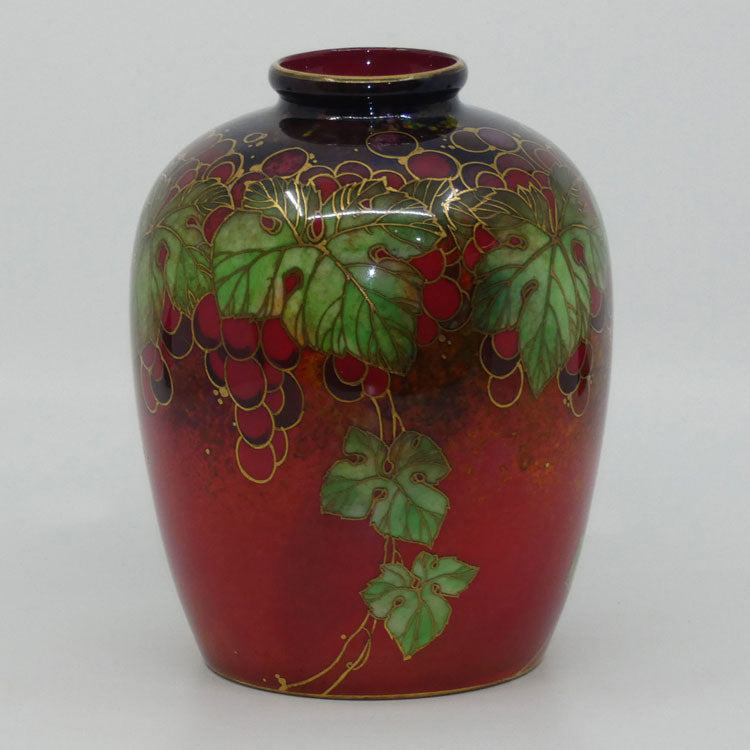Royal Doulton Flambe, Sung and Chang | desirable colourful mistakes

Flambe (pronounced flom-bay, not flam-bee) is a French term used to describe the ancient Chinese high temperature glazes with a red colour. The effect results from a particular method of firing a glaze that involves varying the amount of oxygen in a kiln at certain stages of firing, while adding copper oxide and other substances.
It is thought that the method was first discovered by the Chinese of the Ming dynasty, probably during the reign of Wan-li (1573-1620).
Flambe, in effect, is what is known as a transmutation glaze.
At the turn of the 20th century, Royal Doulton’s Art Director John Slater and Charles J. Noke set out to recreate the mystery of flambe glazes for Royal Doulton. By 1900 only a few pieces had been successfully produced by Royal Doulton, as the firm struggled to consistently produce the desired effect. An enormous amount of money was invested in the production and development of the new wares, but very few items were produced with any degree of consistency.
In about 1902, Cuthbert Bailey – a ceramic chemist – and Bernard Moore, a young and talented potter, joined the Royal Doulton team. This group of men was financially supported by the Royal Doulton firm to produce flambe glazes, and special kilns were built and numerous experimental compositions conducted. Moore, a young (and now infamous) Staffordshire potter, had already achieved success with unusual, experimental type glazes, and he earned the distinction of being the first Englishman to successfully produce the flambe glaze. Henry Doulton both encouraged and financially supported numerous experiments by Slater, Noke, Bailey and Moore in their attempts to recreate the flambé glaze. Success was achieved, and the wares were first shown at the 1904 St Louis Exposition, where Royal Doulton received esteemed praise and won an unprecedented 30 awards.
The flambe glaze had arrived, and to this day captures the hearts and minds of collectors everywhere. History shows that Bailey left Doulton in about 1907, and Noke took over the responsibility for further development and research of the transmutation glazes.
Noke’s objective was to broaden the flambe range of colours and textures, and control some of the veined effects seen in earlier flambé items. He modelled new vase shapes based on oriental forms, along with animal models and figures of Buddha, all of which were decorated with the flambé glaze.
One of Noke’s greatest achievements (and now a highly collectable branch of flambé) was the development of the Sung flambe wares, first seen in 1919. Sung wares are typified by bright yellows, purples, orange and peacock blue colouring, with black beneath the rich flambe glaze. The catalyst for the development of Sung glazes came from the early flambe experiments, in which these additional colours had appeared during firing. The Sung range was created around these colourful ‘mistakes’ .
The premier artists from the Doulton factory – Harry Nixon, Arthur Eaton and Fred Moore – hand painted Sung items with scenes that included fishes in underwater scenes, mythical images of firebreathing dragons and snakes striking at birds, to name just a few. The most elaborate Sung piece seen by the author is that of the Alchemist vase, signed by Charles Noke and in excess of some 45cm tall. Only four of these pieces are known to exist in the world, and the item is worth in excess of $30,000 (we actually sold one at this price).
In 1925, the Royal Doulton creative team comprising Charles J. Noke, together with his son, Cecil, and Harry Nixon, developed another remarkable (and now rare and highly prized) art pottery product called Chang ware. This product was given its name after the ancient Chinese potter Chang the Elder. Chang wares have a thick glaze that flows like lava, and which is allowed to run and crackle down the piece offering numerous colourful effects in rare cases. Generally Chang is seen in the reds, oranges and browns, but on some occasions greens and blues can be seen.
The late 1930s saw a change in the buying tastes of the collecting public, influenced no doubt by the Great Depression. Chang was discontinued before the Second World War, when restrictions on the production of decorative china were enforced. Today, Royal Doulton’s great flambé experiment, and other transmutation glazes such as Chang, are admired, collected and appreciated throughout the collecting world.
To see our extensive range of Royal Doulton Flambe - please visit our dedicated store section
